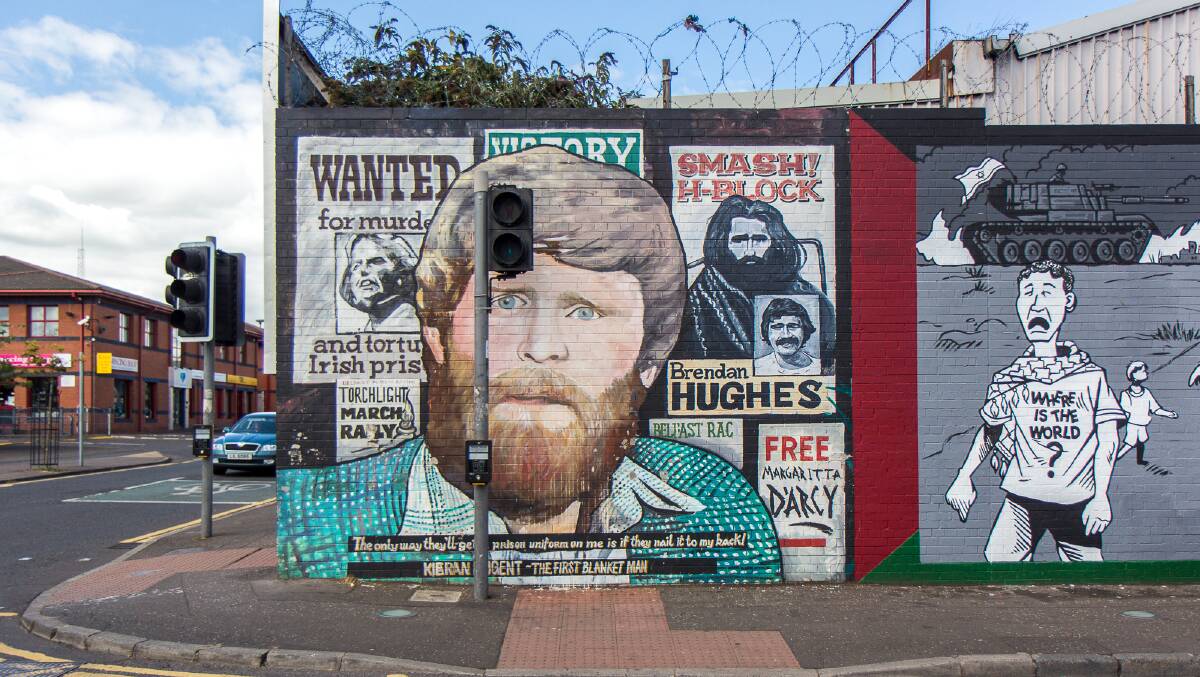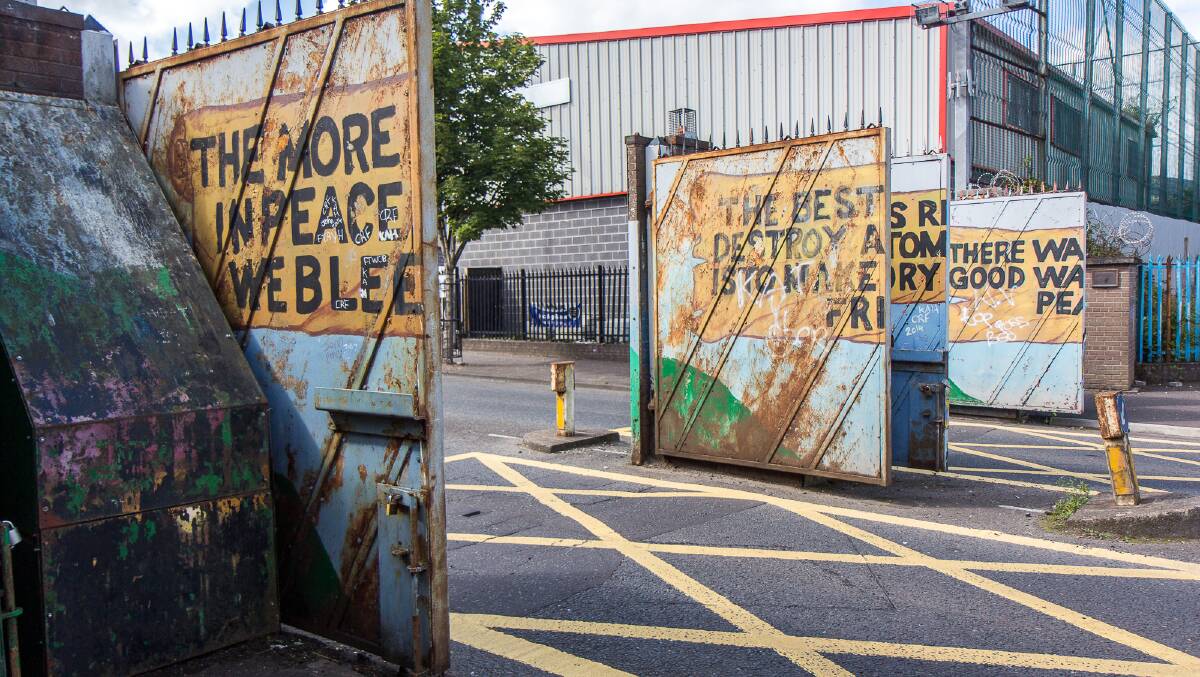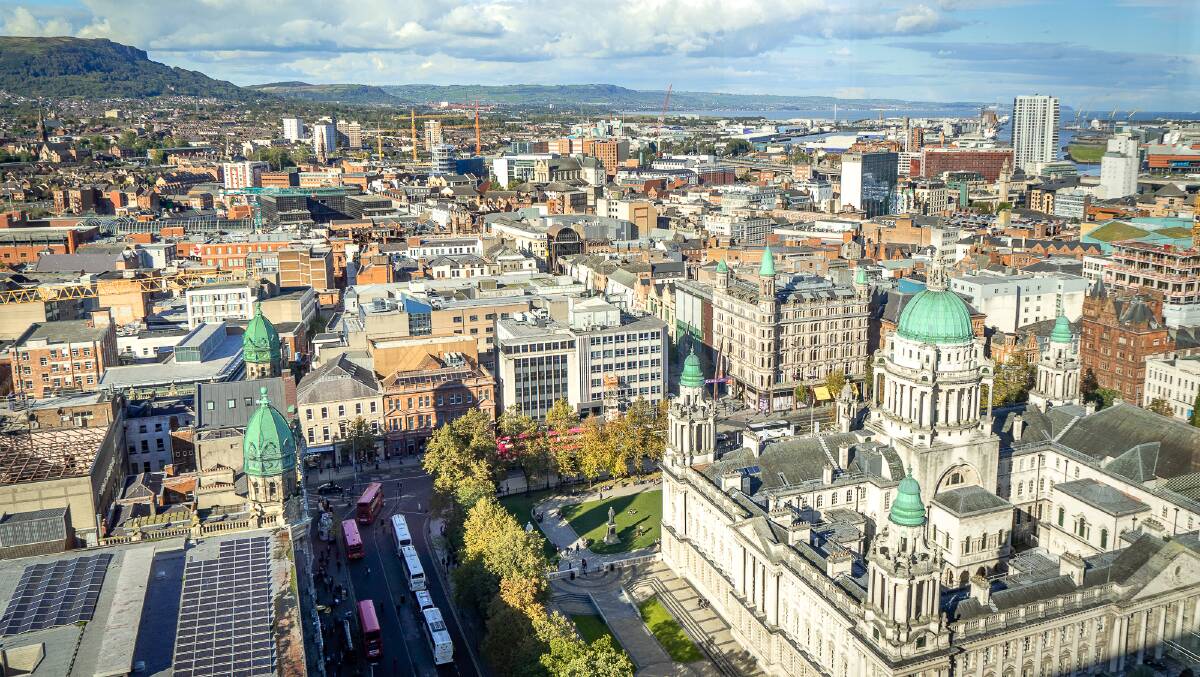Large metal gates locked across streets at night; communities separated by walls up to six metres high; fences covered in murals that talk of oppression and revenge. This is what peace looks like in Northern Ireland.
Subscribe now for unlimited access.
or signup to continue reading
It's hard to come to Belfast and not talk about "The Troubles", the decades-long violent political conflict that engulfed the city from the late 1960s. Because although it may have officially ended with the Good Friday Agreement in 1998, the conflict changed the face of the city and influenced much of what you see today.

I walk down Cupar Way, with two-storey red-brick houses on one side, and an enormous eight-metre-high defensive wall on the other. It's one of the so-called Peace Lines, built to separate warring communities in the city. The first one was erected in 1969, but now there are about 40 of them, stretching for almost 30 kilometres.
What is most striking about these barriers, other than their imposing scale, are the murals that have been painted along many of them. These walls can talk. On the unionist side are images of harmony, calling for calm and cooperation. On the other side, centimetres through the concrete, are the murals of the nationalists, with depictions of political prisoners and heroes who died fighting for their cause.

The Peace Walls, with their murals and associated locations, have become one of the city's main tourist sights. Black-cab tours take visitors to see them, and the guides offer first-hand stories to give as much context as possible. The words on the murals give you a sense of the story ("Our revenge will be the laughter of our children" one says), but can you really understand if you don't hear from someone who lived through The Troubles.

In some ways, people in Belfast are still living through it. The violence may have mostly stopped, but there's still tension, and I'm surprised to see the riot squad set up in one neighbourhood as I come in from the airport. But the Peace Walls - one of the most obvious physical reminders of the issues here - are due to come down next year, potentially changing the face of the city again.
Next year marks 25 years since the Good Friday Agreement, which restored self-government to Northern Ireland. A decade ago, it was agreed that the Peace Walls would be demolished by 2023 to coincide with that anniversary. And, while it looks very unlikely that all the walls will actually come down by then, some are slowly being removed.

It means for tourists, there is only a finite (albeit still undetermined) period in which you'll be able to see these bits of heritage, these symbols that have meant so much to the people of Belfast, representing the anger, the sorrow, and now supposedly the reconciliation. From a traveller's perspective, it will be a shame to see them go because they are an excellent way to be able to explore this important historical period. But, of course, the city needs to move on.
And moving on it is doing. To visit Belfast today is to arrive in a city that would be unrecognisable to anyone who only saw it during The Troubles. There has been massive investment in developing the city centre, improving it for both locals and visitors. One of the biggest changes has been in the area known as the Cathedral Quarter, a maze of cobblestoned streets and warehouses that has become a centre of arts and culture, with concerts, trendy bars and restaurants.

Across the river is one of the city's most iconic new landmarks, the large modern museum called Titanic Belfast. Fifty-three children died when the Titanic sank on its maiden voyage but, for the people of Belfast, it was really 54. The ship, built here, was the city's baby and the museum traces its story from Belfast's industrial history, through the fateful trip of 1912, to modern-day efforts to view the wreckage. It's an incredible attraction and almost worth a visit to the city in itself.
While Titanic Belfast is certainly bringing renewed interest to the city, if there's one thing that's really put the city on the map in recent years, it's the television phenomenon of Games of Thrones, which had its main filming studio here. Numerous sights in the region around Belfast were also used as the setting for iconic scenes in the cultural phenomenon, and a whole industry of tours has emerged taking people to these locations.

The first time I visited Belfast, I bumped into one of the actors in the lobby of the hotel where I was staying - Samwell Tarly (John Bradley), which was a bit of a disappointment because Jon Snow (Kit Harington) had apparently been spotted the day before. But the fact that both I and the Games of Thrones actors were staying in the Europa Hotel, known as the most bombed hotel in Europe (attacked 36 times during The Troubles), shows how much the city has changed.
In the minds of tourists, perhaps the Peace Walls are being replaced by THE Wall from Game of Thrones. And, sure, fantasy is interesting, but history is also important. There's a place for both in Belfast and, for now at least, you'll still find that balance.
You can see more things to do in Belfast on Michael Turtle's Time Travel Turtle website.


